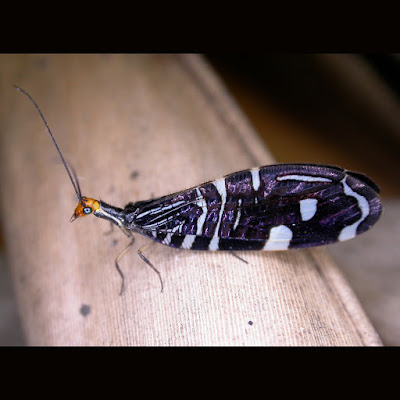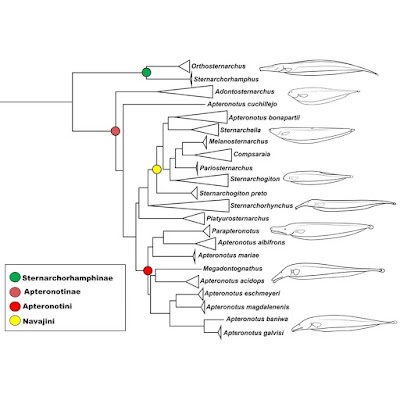[Most Recent Entries] [Calendar View]
Tuesday, April 9th, 2019
| Time | Event | ||
| 3:35a | [Entomology • 2019] Lance Lacewings of the World (Neuroptera: Archeosmylidae, Osmylidae, Saucrosmylidae): Review of Living and Fossil Genera
Abstract The genera of the lance lacewing family Osmylidae (Neuroptera) and extinct allied families (Archeosmylidae, Saucrosmylidae) are reviewed. A key to living Osmylidae genera of the world is presented. Each genus is diagnosed and figured with a checklist of species included for each. New, revised or support for previous taxonomic changes include the following: Nuddsia Menon & Makarkin, 2008 (= Burmaleon Myskowiak et al., 2016 syn. nov.); Kempynus Navás, 1912 (= Clydosmylus New 1983a syn. nov.); Osmylus Latreille, 1802 (= Hyposmylus McLachlan; Dictyosmylus Navás, 1910; Plesiosmylus, Makarkin, 1985; Plethosmylus Krüger, 1913a); Parosmylus Needham, 1909 (= Mesosmylus Krüger, 1913c; Phlebosmylus Navás, 1928 syn. nov.); Thaumatosmylus Krüger, 1913a (= Glenosmylus Krüger, 1913a syn. nov.). New classification changes include: Mesomylidus Jepson, 2012 and Petrushevkia Martynova, 1958 are transferred to Protosmylinae; Lahulus Navás, 1930 is placed in Osmylinae; Stenosmylina Jepson et al., 2009 is transferred to Eidoporisminae. Cratovoluptia Martins-Neto & Rodrigues, 2009 is removed from Osmylidae and transferred to Ithonidae, while Cratosmylus Myskowiak et al., 2015 is transferred to Nymphidae. Idiastogyia Lin, 1986 and Yanosmylus Ren in Ren et al., 1995 are excluded from Osmylidae and placed as incertae sedis in Neuroptera. Keywords: Neuroptera, Osmlyloidea, fossil, lance lacewing, Neuroptera Shaun L. Winterton, Caleb Califre Martins, Vladimir N. Makarkin, Adrian Ardila-Camacho and Yongjie Wang. 2019. Lance Lacewings of the World (Neuroptera: Archeosmylidae, Osmylidae, Saucrosmylidae): Review of Living and Fossil Genera. Zootaxa. 4581(1); 1–99. DOI: 10.11646/zootaxa.4581.1.1 | ||
| 9:16a | [Ichthyology • 2019] Molecular Phylogeny of the Ghost Knifefishes (Gymnotiformes: Apteronotidae)
Highlights: • Most species-comprehensive, data-rich phylogeny of the ghost knifefishes to date. • Multi-locus phylogeny based on three mitochondrial and four nuclear loci. • Orthosternarchus + Sternarchorhamphus placed sister to all remaining genera. • Substantial polyphyly within Apteronotus. • New suprageneric classification for Apteronotidae. Maxwell J. Bernt, Victor A. Tagliacollo and James S. Albert. 2019. Molecular Phylogeny of the Ghost Knifefishes (Gymnotiformes: Apteronotidae). Molecular Phylogenetics and Evolution. In Press. DOI: 10.1016/j.ympev.2019.02.019 | ||
| 9:24a | [Herpetology • 2017] Dendropsophus nekronastes • The 100th: An Appealing New Species of Dendropsophus (Anura: Hylidae) from northeastern Brazil
Abstract We describe a new species of the Dendropsophus leucophyllatus Group from the Atlantic Forest of the southern region of State of Bahia, Brazil. It can be distinguished from all species of the D. leucophyllatus Group on the basis of morphological characters (especially its unique dorsal pattern and snout in dorsal view), advertisement calls and divergence in mitochondrial DNA gene sequences. The inclusion of D. anceps on the group remains controversial but our phylogenetic analyses do not recover the new species as sister to syntopic species of the D. leucophyllatus Group (with or without D. anceps). These results also highlight the palimpsest that is past relation between the Atlantic and Amazon forests. Dendropsophus nekronastes sp. nov. Diagnosis: We assign Dendropsophus nekronastes to the D. leucophyllatus Group based on the presence of the glandular pectoral patches—the putative synapomorphy of the group—and the results of the phylogenetic analysis indicate that new species is nested in the group. The species can be diagnosed by the following combination of character states: (I) SVL 24.1–28.9 mm in males (n = 24) and 31.8–35.4 mm in females (n = 2); (II) short snout (approximately 30% of HL), truncated in lateral view and mucronate in dorsal view; (III) tympanum rounded, tympanic ring distinct, except for the dorsal margin; (IV) canthus rostralis straight and loreal region nearly vertical; (V) dorsum dark brown with white markings consisting of a triangular head blotch connected to dorsolateral stripes that cover the eyelid and extend to the posterior third of body (composing an inverted U-shape, see Fig 2); (VI) a medial white line that extends from the interorbital area to the sacral region; (VII) wide white suborbital marking, as long as eye diameter; (VIII) two nearly transverse white bars in the forelimbs, one in the arm, from the arm insertion point to arm midpoint, and the other from the elbow to the wrist; (IX) shank with a regular dorsal white stripe covering nearly all its surface, from the knee to heel; (X) nuptial pads present, glandular, small, covering only the medial area above the prepollex; (XI) red iris, pupil black, elliptical, and horizontal; (XII) axillary membrane extending to the half of the arm (when positioned transversally to the body); (XIII) pectoral glands present, well-marked, oval, present in both males and females; (XIV) vomerine teeth present; and (XV) advertisement call composed of a series of 1–3 pulsed notes, average duration of 0.305 s and dominant frequency ranging between 4478.0–4823.4 Hz. Etymology: The specific name is by the two Greek words nekro- (death) + -nastes (inhabitant; dweller). The name is given in allusion to the collection site of the specimens in a pond near a cemetery. Geographic distribution: Dendropsophus nekronastes sp. nov. is known only from two ponds at its type-locality, municipality of Almadina, southern State of Bahia, Brazil (Fig 1). Natural history: Dendropsophus nekronastes call in temporary ponds, usually in the surrounding shrubs between 30 and 150 cm of height. Syntopical congeners are D. branneri, D. elegans (MZUESC 10186–10194) and D. anceps (MZUESC 9960–9964). Other species calling at the sites were Hypsiboas albomarginatus, H. crepitans, H. faber, Phyllomedusa burmeisteri, P. rohdei, Physalaemus erikae, Scinax juncae, Sphaenorhynchus pauloalvini and S. prasinus. Iuri Ribeiro Dias, Célio Fernando Baptista Haddad, Antônio Jorge Suzart Argôlo and Victor Goyannes Dill Orrico. 2017. The 100th: An Appealing New Species of Dendropsophus (Amphibia: Anura: Hylidae) from northeastern Brazil. PLoS ONE. 12(3): e0171678. DOI: 10.1371/journal.pone.0171678 |
| << Previous Day |
2019/04/09 [Calendar] |
Next Day >> |




